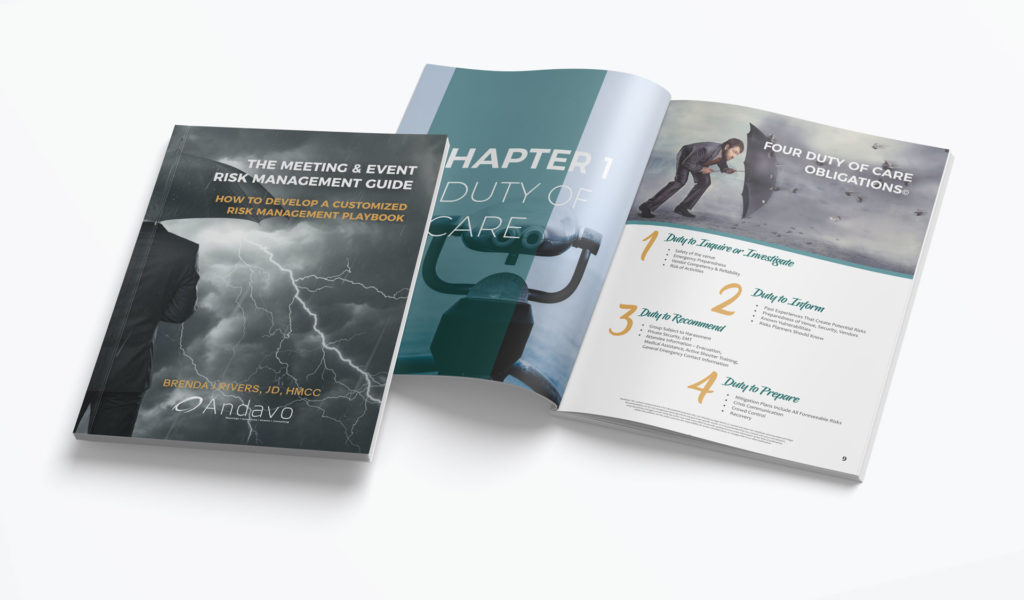The Meeting and Event Risk Management Guide:
How to Develop a Customized Risk Management Playbook
Written from the meeting professional’s point of view, this guide offers a 6-step process to develop a risk management playbook that is replicable for any type of event. Learn the 4 duty of care standards to keep attendees safe and mitigate financial, legal, and reputational damage in advance of a potential crisis. The book contains practical templates, checklists, and procedures which apply to any type of crisis and is designed to integrate in your overall event design.
Your risk management playbook is customizable for any type of meeting or event regardless of the size, location, or complexity.
Critical to the success of risk management is the integration of the 4 Duty of Care Standards with the 6 Step Process of the Playbook.
This Guide is not designed to cover all possible disruptions or crises that could strike an event. The purpose is to assist the meeting organizer with developing a meeting risk management strategy that can be integrated into their meetings and travel program. The 4 Step Duty of Care analysis combined with the 6 Steps of the Playbook is the basis of this strategy. Executive stakeholders value an impact analysis that quantifies threat to the safety of participants, financial and legal impact, and potential damage to your organization’s reputation.
COntents
Results
Your organization and events team will have taken all steps to fulfill their duty of care. Your team will be informed, confident and empowered. There will be a greater sense of connection to the organization, fear and anxiety will be lessened and the company brand enhanced.
Chances are, your event will be flawless, without any risky situations.
But if a crisis occurs, your team will be ready!
INTroduction
Your 4 Duty of Care Standards
An organization’s duty of care is to do all that is reasonably prudent to prepare for foreseeable disasters, regardless of the likelihood. The duty of care begins with a heightened dedication to the safety of not just employees, but all attendees, including sponsors, vendors, exhibitors, spectators, journalists, speakers and invitees.
The organization’s duty of care is a legal duty with consequences. Meeting stakeholders and
planners can be held personally liable for failure to meet their professional responsibility in
areas such as:
- Conducting proper due diligence when sourcing a location and venue
- Informing attendees of potential threats
- Providing attendees with critical emergency procedures such as evacuation routes, exits strategies, medical, security and law enforcement contacts
Duty to Investigate
Your due diligence begins in the planning and RFP process. Here you evaluate location safety, vendor competence, potential but foreseeable disruptions, emergency preparedness, and medical resources.
Duty to Inform
Then, inform your client of the results of your investigation as you present event location options. Once the event is booked, alert attendees of potential risks of attendance.
Duty to Recommend
Based on your professional expertise, training, and due diligence, make recommendations to your client. Should the client: hire more security, train staff, hire outside medical services, rehearse possible disruptions?
Duty to Prepare
Finally, prepare the crisis response plan, assign roles and responsibilities, create a communication strategy, and develop a recovery process.
1
Assess Current State of Prepareness
Understand how your organization mobilizes to respond in a meeting crisis. Evaluate current competencies and gaps in how your stakeholder event teams prepare for different crises and protect the company’s investments.
2
Conduct a Vulnerability Study
The meeting or event design must begin with a vulnerability assessment to determine the potential risk for the event, followed by a sourcing process for a safe location, hotel, venues and activities with the purposeful engagement of vetted suppliers hired security, input from local law enforcement and access to medical support. This preparation must be systematic, procedural and documented with a communication strategy that includes social media channels
Once you understand your current state of preparedness, where the gaps are, what matters most to your organization and meetings team, you are ready to build your customized playbook. Each separate meeting or event should always begin with a vulnerability study to determine the foreseeable risk factors:
- What kinds of disruptions and disasters are foreseeable in the location, hotel, venue?
- What is the political climate and weather patterns?
- Are your participants, speakers, subject matter experts, or sponsors possibly controversial? What is the crime rate in and around your location and/or hotel?
- What is the history of labor strikes, protests, natural and man-made disasters and pandemics?
- What other risk factors should a prudent meeting planner know about?
3
Identify Responders and Resources
The first step in preparing your crisis response plan is to identify your resources. Who can you call on to assist with avoiding and mitigating crises at your event? Perhaps you have hired a private security team, or a destination management company. Who are your primary security contacts at the venue you have selected? What other vendors are you using for travel, transfers, production, or offsite events? Perhaps you are working with a local agency or sponsor to plan some of your events. Make a list of all your primary contacts, as these will be your support network.
Private security team
Other security contacts
Destination management company
Vendors for travel, transfers, production, offsites
Local agency
Sponsors
4
Develop Crisis Response Plan/s
Now that you have established what partners you can call on in an emergency, your venue’s standard procedures, as well as your organization’s existing policies, you are ready to begin outlining your contingency plans for the concerns you identified in your vulnerability assessment. There are two ways to approach contingency plans:
Identify the issues that could arise and identify the steps that should be taken should they occur. (i.e. “If this happens, then this will be the procedure.”) If you find in your vulnerability assessment that there are numerous vulnerabilities that could occur while you are onsite, this may be the approach to take.
Consider outlining responsibilities of both your company and any partners/vendors involved in the event.
Identify the possible alternative event outcomes, and the elements that would contribute to that outcome. (i.e. What would have to happen to warrant a cancellation of the event? Moving the event,
dates or location?) If you are vulnerable to ongoing or pre-event issues (such as political climates, existing weather patterns, etc.), this approach may help you determine your course of action on site ahead of time.
5
Integrate the Crisis Communication Plan
One of the most crucial ways to preserve your company’s reputation in an event crisis is to have a fully developed crisis communication plan. Recognize that you cannot have a plan for everything, but you can survive and thrive in the face of seemingly insurmountable odds if you know some things in advance.
- How decisions will be made
- Who has decision-making authority
- Chain of Command: how, when and what should becommunicated, and to whom?
Keep to this format:
- What just happened?
- What is happening now?
- What is the plan moving forward?
The communication style must be calm and confident. Have a crisis communication plan that easily taps into social media and the event app. Increased use of these mediums means that more people will participate, so these channels serve as an invaluable way to reach out to people during a crisis to get their feedback and keep tabs on their concerns, perceptions, and ideas. Maintain factual messaging that is not based on conjecture and include a summary of past and present events and what is reasonable to predict. Delivery should be calm and thoughtful, addressing the fact that people are scared, angry, frustrated or feeling vulnerable.
6
Recover and Evaluate
Your event debrief is an important step in the overall meeting management process. Reviewing what went well and what didn’t will help you make important changes for future years.
- How could the crisis have been avoided or reduced in magnitude?
- What worked well during the initial crisis response? What were the unpleasant surprises and disappointments?
- What little things really made a difference, or would have made a difference if they were available?
- How could we have saved money during this crisis?
- How well did our existing contingency plans work? What else was needed?
- What’s your assessment of the news media coverage and its impact on the organization?
- How could we have handled it more effectively?
- Who in our organization really stands out in your mind—positively and negatively—in terms of their contribution to the crisis response?
- What are the “If I had to do it all over again” lessons?





